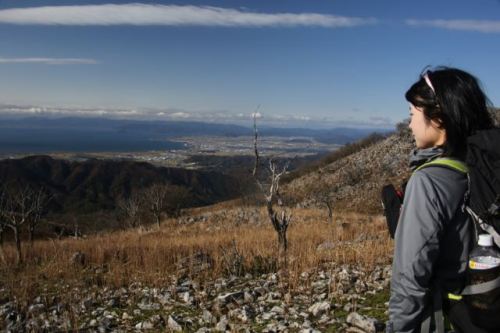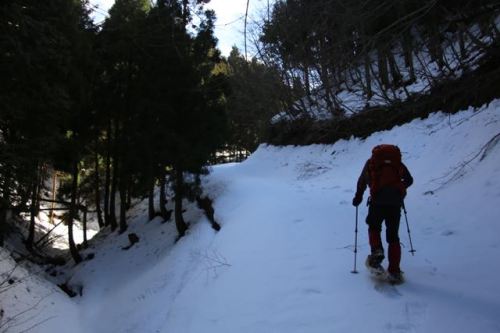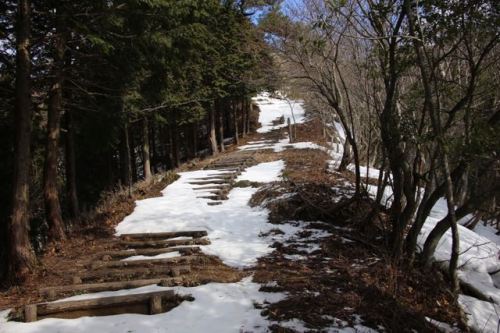Amazing mountains deserve subsequent visits, and Mt. Ryozen is no exception. I became mesmerized by the Scottish feel of the summit plateau during my first climb on a frigid March morning, and dreamed of heading back in the autumn to take in the golden hues of the meandering grasslands. Noteworthy peaks are like a good bottle of bubbly – they are best shared and showed off to close counterparts, so I turned to my companions from the latest Gathering and settled upon a date in late November that just happened to coincide with a stable high pressure system.

Miguel, Eri, Rika and I alighted at Samegai station in eastern Shiga Prefecture, where Paul D. was waiting with a warm smile and an eager look on his face. With such perfect weather at our disposal, such looks were well understood, as we were all itching to make full use of the brilliant daylight. The bus was set to depart in 15 minutes, leaving Eri just enough time to dash to the nearest convenience store to stock up on provisions for the long hike. From the bus stop to the summit, we faced a 7-1/2 km one-way hike, the first 4 kilometers of which were on a paved forest road will little to no vehicular traffic. We each hit the tarmac at our own pace, settling in on a rhythm while catching up the latest news. It was our first time to hike with Rika, a feisty Fukuoka native who had recently relocated to Kobe to work for Finetrack. Her sense of humor helped break up the monotony of walking on a road we easily could have driven in luxury.

The waterfall route I had taken on my first visit was washed out in a typhoon some years ago, which necessitated our current, longer approach via the forgotten remains of Kuregahata village. The farming hamlet was home to 50 households during the Meiji era, but life was rough for the 245 inhabitants, as the winter snows brought accumulation of several meters, cutting off access to the larger towns of Maibara and Hikone. Residents slowly relocated to lower, drier ground over the ensuing years, until the strict food rations during World War II forced the remaining habitants to migrate towards the more populated enclaves. The final death blow was dealt soon after, as the local elementary school shuttered its doors and essentially hindered anyone to returning to settle. Nowadays the building foundations and vegetable fields provide campsites near the public-run mountain hut, which gives off an eerie, Blair Witch feel. We moved through the area swiftly, anxious to reach the warmth of the sun’s rays up on the ridge.

The path switchbacks abruptly out of Kuregahata, reaching a mountain pass whose Kanji characters read “sweat wiping”. The name was most appropriate, for not only were we dabbing the sweat away from our brows, but we were also shedding excess layers under the pleasantly balm November temperatures. The trail hugs the ridge, with abrupt drops off the southern face towards the hissing sound of flowing water concealed by the burning foliage in full autumnal display. Our progress was brought to a halt more than once as nature put on a slideshow worthy of pause.

I was beginning to worry about our snail’s pace up towards the summit plateau, for we still had quite a long way to go just to reach the ridge before an even longer traverse to the high point. There were just too many distractions along the way – a rusty shovel hidden among the freshly fallen leaves provided minutes of spontaneous role play opportunities that could just not be passed up. With such an amicable cast of characters to our unfolding drama, we took it all in stride as the vistas began to reveal their magical selves. Humble villages hugged the jigsaw shoreline of Japan’s largest freshwater lake, as a ring of rugged massifs encircled the cove, mimicking the masts of warships ready to set sail at the slightest sign of trouble. It was in these broad flatlands that Japan’s most intense struggle for unification took hold that ultimately ushered in the reign of the Tokugawa clan and the seclusionist policies of the Edo era.

We paused at one such overlook, admiring the views when a party of three elderly hikers greeted us on their descent from the rocky plateau above. Upon ushering our greeting, the trio responded with an air of recognition, as if they were being reunited with a long-lost friend. “Didn’t we meet you on Mt. Amagoi?”, inquired the tallest of the three. During our ascent of a peak just across the valley, Paul and I did run into these good-natured folks, who informed us about the Suzuka 12, a supplementary list to the original Suzuka 7 mountains that included 5 extra peaks on the Shiga side of the range. This time around we posed for a commemorative photo before continuing on our push against the force of gravity.

Soon the rolling hills of the true ridge came into view, and after a few switchbacks we left the trees behind and arrived on the summit of the first peak, marked by a signpost indicating that we were 70% of the way there. This proved an ample resting place for lunch, with a gentle breeze, unhindered views, and plenty of fresh peanut butter to go around. It would have been easy to give into temptation and laze around for a few hours, but summit fever soon took hold, as we pushed on towards the top.

Looks can be quite deceiving, as the lack of tree cover revealed the surprisingly long ground we still had left to cover. I had come from the completely opposite direction on my first visit, so this was still virgin territory. After passing by an idyllic pond marked by a small shrine, the trail veered towards the right, rising steadily towards a parallel ridge line with ever-expanding views. At the crest of the knoll, the iconic hump of Mt. Ibuki came into full view, flanked on the right across a broad valley by the smoldering cap of Ontake. Closer at hand, the emergency hut stood guard, looking as if it were plucked from Grindelwald and plopped down on the soaring plateau. Mt. Ena held silent vigil across the subdued lowlands of Aichi, waiting patiently for the first flakes of snow to fall on the gentle curves of her sacred flank.

Rika and I pushed out slightly ahead of the others, as we were soon approaching our 2pm turnaround time. The path dropped to a long saddle before the final steep push to the high point, offering panoramic views of the remainder of Suzuka’s foreshortened layer of contorted ridges. The summit boulders offered ample space for stretching out and taking in the splendid autumn views. From our eagle’s perch we tracked the progress of our fellow companions, tracing their outlines as they all successfully arrived on the top. We spent a few minutes taking in the wonderful scenery before reluctantly turning away for the long return to the bus stop. The final bus was at 5pm, which left us about 2-1/2 hours to cover the 7.5km descent. Just before pushing off a trip of French climbers arrived at the summit. They had heard about this hike from my very own Hiking in Japan website and were more than pleased with my recommendation.

On the ascent, I spied a shortcut at the col that would shave about a half an hour off our descent and led our group on a narrow deer trail through the golden grasses. Our downward progress was steady but never felt rushed, and soon we regained the fiery foliage of the deciduous forest and slowed our pace to savor those fading tints of the waning season. Once back on the forest road we kept a constant eye on the clock, and with our perseverance we arrived back at the bus stop with just minutes to spare before the final bus of the day. At the station, the French trio we met on the summit came strolling in well after sundown. Perhaps I need to upgrade my difficulty rating on my website less one of my readers meet with ill luck.











